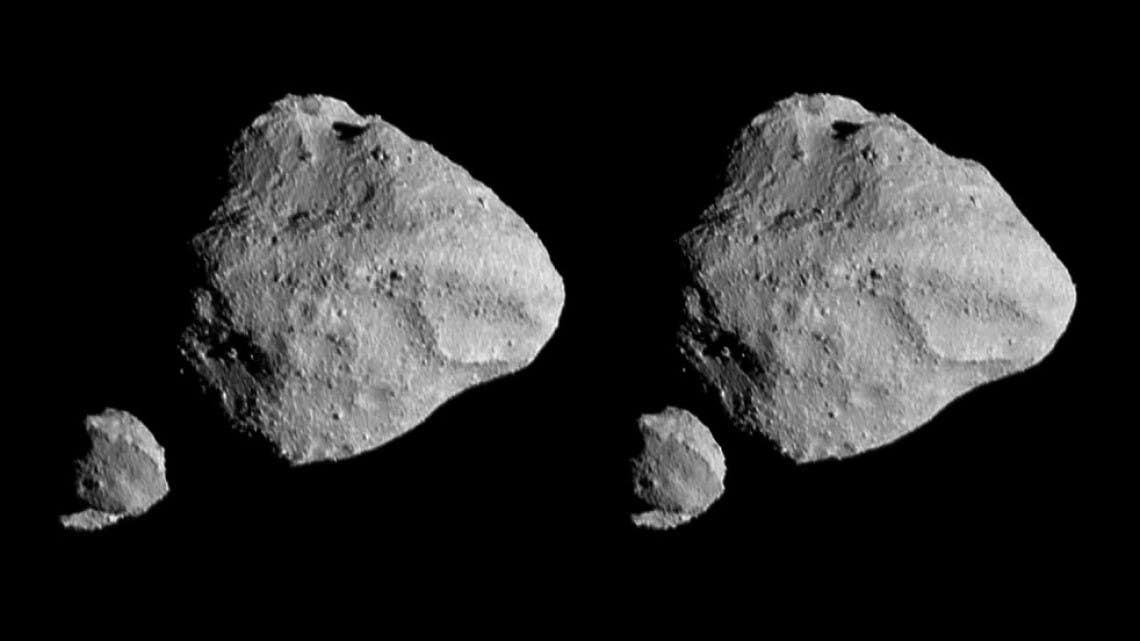Astronomers discover ‘baby’ asteroid circling between Mars and Jupiter
In a recent Lucy mission unveiled a surprising discovery – a tiny moonlet dubbed Selam orbiting the asteroid Dinkinesh.

In November 2023, the Lucy mission unveiled a surprising discovery – a tiny moonlet dubbed Selam orbiting the asteroid Dinkinesh. This newfound celestial duo resides within the main asteroid belt, a region between Mars and Jupiter littered with remnants of our early solar system.
Now, a Cornell University-led research team has peered into Selam's past, estimating its age to be a mere 2-3 million years old – a veritable toddler in the solar system's 4.5-billion-year timeline.
A Novel Approach to Dating Asteroids
Traditionally, scientists have relied on counting craters on an asteroid's surface to estimate its age. The more craters present, the older the asteroid is assumed to be. However, the Cornell team has pioneered a new technique that leverages orbital dynamics – the intricate dance of celestial bodies governed by gravity – to determine Selam's age.
This method analyzes how Dinkinesh and Selam interact gravitationally, providing valuable insights without the need for a dedicated spacecraft to capture close-up images.
Advantages of the Dynamical Dating Method
The dynamical approach offers several advantages over traditional crater-based methods. Firstly, it bypasses the requirement for expensive spacecraft missions to capture high-resolution images.
Secondly, it holds promise for improved accuracy in cases where the asteroid surface has undergone recent changes, potentially obscuring the true crater count. Finally, and perhaps most significantly, this method can be applied to numerous binary asteroid systems – a category encompassing roughly 15% of near-Earth asteroids.
Unveiling Selam's Youth
Colby Merrill, a doctoral student in aerospace engineering at Cornell and lead author of the research paper published in Astronomy & Astrophysics, highlights the significance of their findings: "Understanding the age of asteroids is crucial to comprehending their formation history. Selam's remarkably young age suggests a recent formation event, and by studying this single body, we can gain valuable insights into the entire population of binary asteroids."
Related Stories
Merrill, an expert in orbital dynamics and a participant in NASA's Double Asteroid Redirection Test (DART) mission, was captivated by the Lucy mission's discovery of Selam during its flyby of Dinkinesh.
Described by Merrill as "an extraordinarily unique and complex body," Selam stands out as the first "contact binary" ever observed orbiting another asteroid. Contact binaries are essentially rubble piles held together by their own gravity, forming a distinct, two-lobed structure.
The Binary Asteroid Tug-of-War
Binary asteroids, like Dinkinesh and Selam, are captivating celestial objects locked in a continuous gravitational tug-of-war. As gravity pulls on these objects, they bulge outward, creating tides that gradually deplete the system's rotational energy.
Meanwhile, the Sun's radiation exerts its own influence, altering the binary system's energy through a phenomenon known as the Binary Yarkovsky-O'Keefe-Radzievskii-Paddack (BYORP) effect. Ultimately, the system reaches an equilibrium where the tidal forces and BYORP counteract each other, creating a state of dynamic balance.
Unraveling Selam's Formation Timeline
The research team, capitalizing on the assumption of equilibrium between tidal forces and BYORP, utilized publicly available data from the Lucy mission to estimate the timeframe required for Selam to reach its current state. They developed a model that factored in the time needed for Selam to evolve from surface material ejected from a rapidly spinning Dinkinesh.
This model significantly improved upon existing models by incorporating the distinct densities of the two bodies and accounting for the secondary body's mass, a previously neglected factor. By running millions of simulations with various parameters, the team calculated a median age of 3 million years for Selam, with a most likely age of 2 million years.
The calculations suggest the asteroid Selam is younger than the human-ancestor fossil on Earth for which it is named – the skeletal remains of a 3-year-old girl found in Ethiopia, determined to be 3.3 million years old. Selam means “peace” in Ethiopia’s language and has also been nicknamed “Lucy’s baby,” referring to famous human-ancestor remains found in 1974 and dubbed Lucy, or Dinkinesh. The NASA mission named for Lucy is on its way to studying Trojan asteroids in Jupiter’s orbit in 2027.
Looking Ahead: Expanding the Application
The research team is optimistic about applying their innovative dynamical dating method to other well-characterized binary systems, even in the absence of dedicated flyby missions.
Alexia Kubas, a doctoral student in astronomy and space sciences and co-author of the paper, emphasizes the potential of this combined approach: "By using both crater counting and our dynamical method in tandem, we can achieve a more accurate age determination for a binary system. When these two independent methods yield similar results, it strengthens our confidence in the estimated age, providing a more comprehensive understanding of the system's current state."
The discovery of Selam, a youthful asteroid moonlet, and the development of a novel dynamical dating method mark a significant step forward in our understanding of the formation and evolution of asteroids.
This research paves the way for unraveling the history of numerous binary asteroid systems, offering valuable insights into the early solar system.
For more science and technology stories check out our New Discoveries section at The Brighter Side of News.
Note: Materials provided above by The Brighter Side of News. Content may be edited for style and length.
Like these kind of feel good stories? Get the Brighter Side of News' newsletter.



